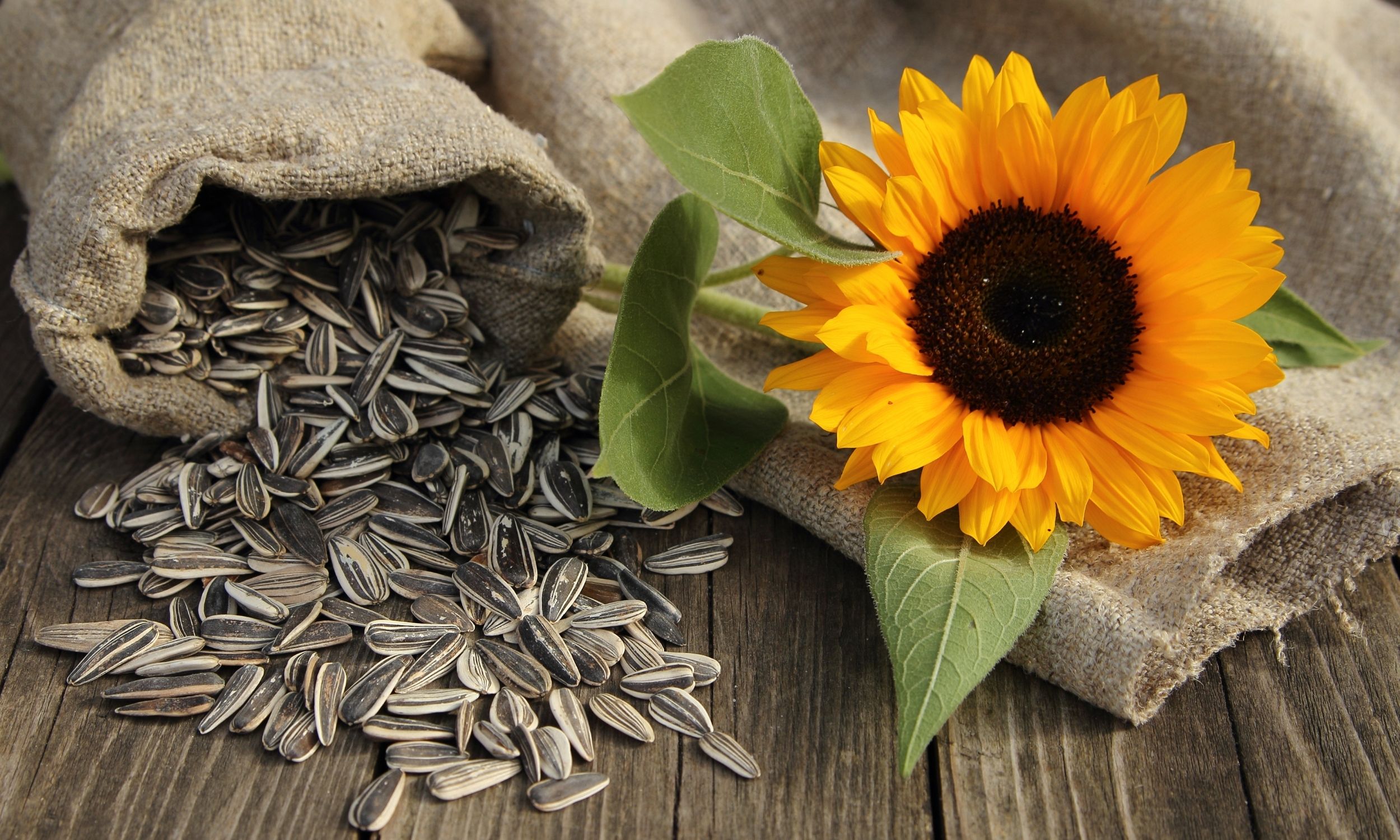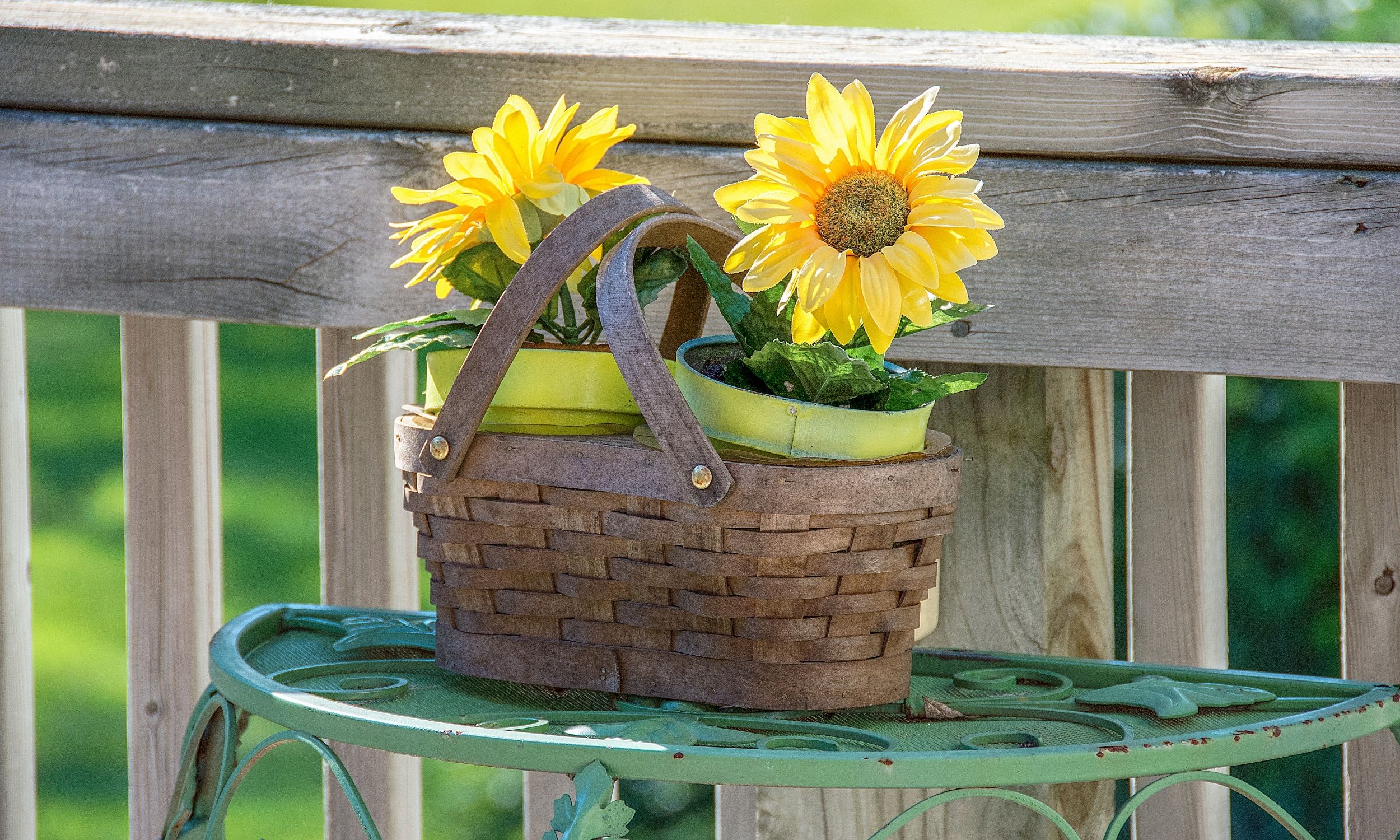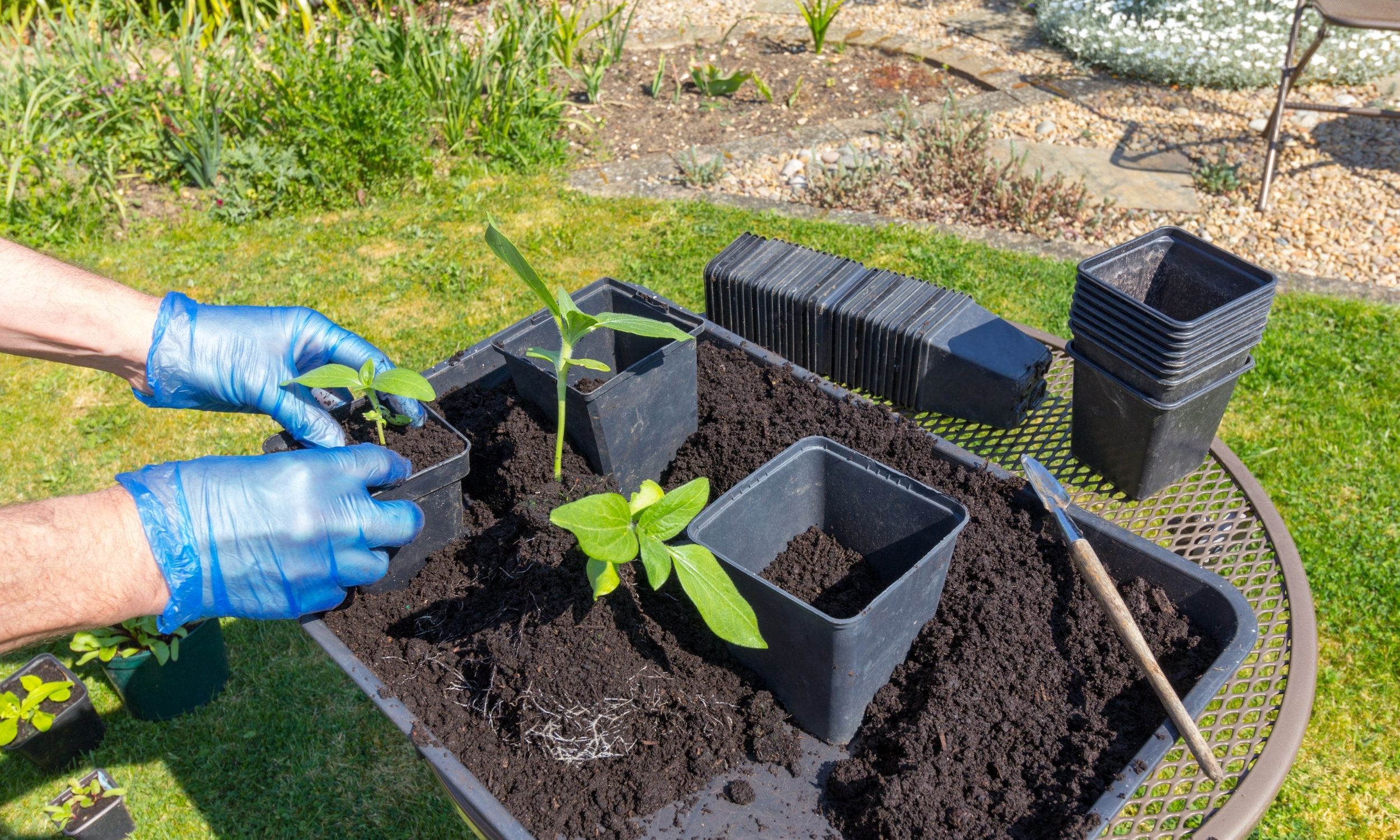How to Grow Sunflowers
Sunflowers. Does anything shout “Summer!!!!” more than bright, sunny Sunflowers?!? With bright blooms that go from mid-summer to early fall, sunflowers say “summer” like no other plant. Plus, 2021 has been designated the “Year of the Sunflower!” What better way to celebrate than growing some yourself?
Disclosure: Some of the links below are affiliate links, meaning, at no additional cost to you, I will earn a commission if you click through and make a purchase.
The sunflower (Helianthus annuus) is an annual plant with a large daisy-like flower face. Its scientific name comes from the Greek words helios (“sun”) and anthos (“flower”). The flowers come in many colors (yellow, red, orange, maroon, brown), but they are commonly bright yellow with brown centers that ripen into heavy heads filled with seeds.
Sunflowers are heliotropic, which means that they turn their flowers to follow the movement of the Sun across the sky east to west, and then returns at night to face the east, ready again for the morning sun. Heliotropism happens during the earlier stages before the flower grows heavy with seeds.
There are tons of varieties of sunflowers available today, so there’s bound to be one that fits your garden. Choose between those with branching stems or single stems, those that produce ample pollen for pollinators or are pollen-free (best for bouquets), those that stay small or tower above the rest of the garden, or those that produce edible seeds!
Check out How to Choose the Best Variety of Sunflower for Your Garden.

How Long do Sunflowers take to Bloom?
A fairly fast-growing flower for their size, most sunflower varieties mature in only 80 to 95 days. The largest sunflower varieties grow to over 16 feet in height, while smaller varieties have been developed for small spaces and containers and rarely grow larger than a foot tall! The flower heads can reach over 12 inches in diameter within the large seeded varieties.
Choosing Sunflower Seeds
There are so many different Sunflowers to choose from. It can feel very overwhelming, so let’s break it down a bit. It’s important to know:
- Not all Sunflower varieties make good cut flowers.
Sunflowers can be roughly divided into 3 uses:
- Oilseed Type – grown for oil, birdfood, etc. When you see photos of HUGE sunflower fields, this is usually the type they are growing. The end product is the seed, not the bloom. These do not make good cut flowers.
- Confection Type – grown for human consumption, like the kind of sunflower seeds you eat at a baseball game. Again, the end product is the seed, not the bloom. These do not make good cut flowers.
- Ornamental – grown for decorative use and cut flower use. This is the kind you will find in most gardening seed catalogs. This is they type of sunflower we will be discussing in the rest of the post. Some types are better than others for cut flower use.
- Ornamental Sunflowers can be divided into 2 main categories:
Single Stem: This type produces one flower on one stem
- Once the bloom as been harvested, it will not send up another bloom.
- Most commercially grown Sunflowers for cut flower use are Single Stem varieties.
- These types of sunflowers are almost always Hybrid seeds (F1), which means the seeds will not save true to type.
- Some are available as “pollenless”. This is helpful for people with allergies.
- The stems are long and straight (Sunflowers should have a stem length of about 24”).
- They grow extremely fast, some varieties going from seed to bloom in 55 days!
- Because they are a “once and done” type flower, you will need to plant new seeds every 10-14 days May- August if you want blooms all summer.
Branching: This type will send out multiple blooms from one main stem
- The blooms will mature over 1-2 weeks, extending the bloom time of the plant.
- Most sunflower grown for garden or decorative use are Branching varieties.
- They come in a wide variety of colors. The stems are often too short to make a good
cut flower (unless you “pinch” the plants very early in their growth)
- Even though they produce multiple blooms, you will still need to plant new seeds about every 2 weeks May – August if you want blooms all summer.
Here are some of my favorite Sunflowers to use in bouquets
- “ProCut Orange” (single stem)
- “ProCut Gold” (single stem)
- “ProCut Plum” (single stem)
- “ProCut Brilliance” (single stem)
- “Vincent’s Choice” (single stem)
- “Cherry Rose” (branching)
- “Autumn Beauty” (branching)
- “Soraya” (branching)
- “Starburst Panache” (branching)
- “Starburst Lemon Aura” (branching)
- “Strawberry Blonde” (branching)

Planting
When to Plant Sunflowers-
It’s best to sow sunflower seeds directly into the garden (or outdoor containers) after the danger of spring frost has passed anytime after soils have warmed to at least 50°F (10°C).
Sunflowers are very forgiving and can be transplanted or direct sown.
If you have problems with birds, squirrels or chipmunks, you may want to start the seeds indoors as transplants to prevent the seeds from being gobbled up! The seeds grow FAST and will be ready to transplant out in less than 2-3 weeks. Do not leave them in the seed trays for much longer than that. Carefully transplant them outside, taking care not to disturb the roots. You can also direct sow the seeds. Poke a hole with your finger, drop in 2 seeds (in case one doesn’t germinate), cover the hole and you’re done. Thin to one plant per hole if they both germinate.

Plan Your Garden with the
Garden Planner & Journal
Everything you need to plan your garden, stay organized, and reflect on the growing season!
Where to Plant Sunflowers-
Find a sunny spot! Sunflowers grow best in locations with direct sunlight (6 to 8 hours per day); they require long, hot summers to flower well.
Choose a location with well-draining soil. It shouldn’t pool water after it rains.
Sunflowers aren’t picky but the soil can’t be too compact. They have long tap roots that need to stretch out; in preparing a bed, dig down 2 feet in depth and about 3 feet across.
They’re not too fussy when it comes to soil pH either. Sunflowers thrive in slightly acidic to somewhat alkaline soil (pH 6.0 to 7.5).
Sunflowers are heavy feeders, so the soil needs to be nutrient-rich with organic matter or composted (aged) manure. Or, work in a slow release granular fertilizer 8 inches deep into your soil.
For Single Stem Sunflowers: Plants should be spaced 4-9” apart. I usually do 6” spacing. The closer the plants are spaced, the smaller the blooms will be, which can be desirable for bouquets. Plants spaced farther apart will produce larger blooms.
For Branching Sunflowers: Plants should be placed 12”-24” apart. I usually do 18” spacing.
If possible, plant sunflowers in a spot that is sheltered from strong winds, perhaps along a fence or near a building. Larger varieties may become top-heavy and a strong wind can be devastating.

Planting Sunflower Seeds-
Sunflowers should be planted 1 to 1-½ inches deep and about 6 inches apart after the soil has thoroughly warmed. If you wish, you can plant multiple seeds and thin them to the strongest contenders when the plants are six inches tall.
Give plants plenty of room, especially for low-growing varieties that will branch out. Make rows about 30 inches apart. (For very small varieties, plant closer together.)
A light application of fertilizer mixed in at planting time will encourage strong root growth to protect them from blowing over in the wind.
Experiment with plantings staggered over 5 to 6 weeks to keep enjoying continuous blooms.
If you see birds scratching around for the seeds, spread netting over the planted area until seeds germinate. See more ways to keep birds away from your garden.
Caring for Sunflowers-
While the plant is small, water around the root zone, about 3 to 4 inches from the plant. To protect the plant, it may help to put snail or slug bait around the stem.
Once the plant is established, water deeply though infrequently to encourage deep rooting. Unless the weather is exceptionally wet or dry, water once a week with several gallons of water.
Feed plants only sparingly; overfertilization can cause stems to break in the fall. You can add diluted fertilizer into the water, though avoid getting the fertilizer near the plant’s base; it may help to build a moat in a circle around the plant about 18 inches out.
Branching sunflowers are capable of producing multiple long stemmed blooms per plant IF THEY ARE PINCHED. Plants that are not pinched usually produce many blooms, but the stems are so short and thick, it renders them unusable for cut flower use.
In contrast, pinched plant can produce 6-10 long stemmed blooms that are perfect for cut flower use. 10 blooms from 1 seed! That is an incredible ROI (Return on Investment)! Pinching MUST take place early in their growth, when the plants are about 8”-12” tall (less than knee high). Pinching alters the growth habit of the plant, causing all the stems to originate
from one point on the plant. To pinch, simply locate the central bud on the plant (it will be tiny, less than the size of a pea) and dig it out with your thumbnail. That’s it!
*DO NOT PINCH SINGLE STEM SUNFLOWERS.*
Tall species and cultivars require support. Bamboo stakes are a good choice for any plant that has a strong, single stem and needs support for a short period of time.
Harvesting-
We’ve all oooh and aaahed over those gorgeous photos of sunflower fields…. but:
Those are likely Oilseed Sunflowers, not Ornamental Sunflowers.
Sunflowers grown for cut flower use actually need to be harvested BEFORE they open!
Yup. That’s right. Before they are open, before you can see their pretty faces. You can allow them to open up in the field if you want to enjoy them in their “natural habitat” but if you want them for the vase, they are “over ripe” once they are open fully and won’t last as long.
For the longest vase life, you want to harvest the stem when you notice a few petals starting to lift off the face (as pictured to the left). As always, harvest in the cool of the day (morning or evening). This prevents wilting. If you do have to cut in the heat of the day, be sure to allow the stems to rest (condition) in a cool dark place for a few hours to revive them. Cut the stems about 24” deep and strip off nearly all the foliage (you can allow a few leaves to remain at the top, if desired).
When Sunflowers are cut at this stage, you will get a much longer vase life. The flower will open fully over the next day or 2.
If you are displaying the Sunflowers immediately, no special treatment is needed, besides allowing them to rest in a cool, dark area for a few hours. However, if you want to store unopened blooms for later (because they all tend to be ready at once!), you can place them in a cooler or refrigerator for about a week. This will delay opening. Once removed from cold storage, the blooms will open up normally. Sunflower are a somewhat “dirty flower”. They tend to make the water get gross. Dirty water breeds bacteria, the enemy of cut flowers. Bacteria significantly reduces vase life. To combat this, it’s important to change the water at least once a day or use commercial flower food (easily found on Amazon – I like “Chrysal Flower Food“)
